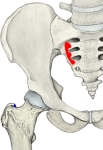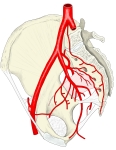梨状筋 ( りじょうきん、 英 : piriformis muscle )
・ 概 要 |
・ 作 用 |
・ イラスト掲載サイト |
|
・ イラスト |
・ 神経 / 脈管 |
||
・ 起始 / 停止 |
・ Wikipedia |
![]()

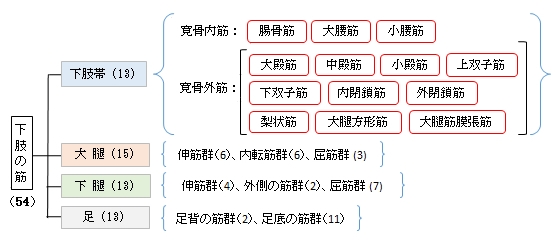

![]()

・梨状筋が座骨神経を圧迫してしまうことがしばしばあり、これを 梨状筋症候群 と呼ぶ。
以下は「船戸和也のHP」の解説文となる。
「梨状筋は骨盤の後側の深層にある回旋筋で仙骨の骨盤筋膜(前仙骨孔およびそれらの外側の)と仙腸関節の関節包から、大坐骨切痕上縁に由来する線維束とともに、起始する。大坐骨孔を通過して、同孔を梨状筋上孔と下孔に分け、大腿筋の深層を骨盤外側をおおって走り、大転子先端の内側に至る。広い起始に始まり、梨状筋は次第に収束して細い停止腱となる。股関節と停止腱は滑液包により隔てられる。坐骨神経の梨状筋枝から支配を受け、股関節の外転、伸展および外旋を行う。」
![]()
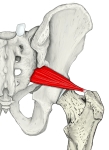 |
 |
|||
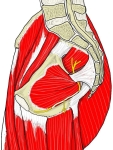 |
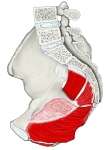 |
|||
![]()
【 起 始 】 : 仙骨前面、上位3つの前仙骨孔間とその周辺
![]()
「 大腿を外側方に回転(外旋)する。」 ( 日本人体解剖学 )
![]()
・ 神 経 : 仙骨神経叢(S1, S2) ※「日本人体解剖学 (上巻) 」ではL5を含めている。
The piriformis (from Latin piriformis, meaning 'pear-shaped') is a muscle in the gluteal region of the lower limb. It is one of the six muscles in the lateral rotator group.
It was first named by Adriaan van den Spiegel, a professor from the University of Padua in the 16th century.
【Structure】
The piriformis muscle originates from the anterior (front) part of the sacrum, the part of the spine in the gluteal region, and from the superior margin of the greater sciatic notch (as well as the sacroiliac joint capsule and the sacrotuberous ligament).
It exits the pelvis through the greater sciatic foramen to insert on the greater trochanter of the femur. Its tendon often joins with the tendons of the superior gemellus, inferior gemellus, and obturator internus muscles prior to insertion.
The piriformis is a flat muscle, pyramidal in shape, lying almost parallel with the posterior margin of the gluteus medius.
It is situated partly within the pelvis against its posterior wall, and partly at the back of the hip-joint.
It arises from the front of the sacrum by three fleshy digitations, attached to the portions of bone between the first, second, third, and fourth anterior sacral foramina, and to the grooves leading from the foramina: a few fibers also arise from the margin of the greater sciatic foramen, and from the anterior surface of the sacrotuberous ligament.
The muscle passes out of the pelvis through the greater sciatic foramen, the upper part of which it fills, and is inserted by a rounded tendon into the upper border of the greater trochanter behind, but often partly blended with, the common tendon of the obturator internus and superior and inferior gemellus muscles.
【 語 句 】
・gluteal:殿部の ・sacrum:仙骨 ・greater sciatic notch:大坐骨切痕 ・sacroiliac joint:仙腸関節 ・capsule:関節包 ・sacrotuberous ligament:仙結節靭帯 ・pelvis:骨盤 ・greater sciatic foramen:大坐骨孔 ・greater trochanter:大転子 ・femur:大腿骨 ・superior gemellus muscle:上双子筋 ・obturator internus muscle:内閉鎖筋 ・prior to~:~より前に ・gluteus medius:中殿筋 ・fleshy:多肉質の ・digitation:指状突起 ・anterior sacral foramina:前仙骨孔 ・groove:溝 ・greater sciatic foramen:大坐骨孔
【Variation】
In 17% of people, the piriformis muscle is pierced by parts or all of the sciatic nerve. Several variations occur, but the most common type of anomaly (81% of anomalies) is the Beaton's type B which is when the common peroneal nerve pierces the piriformis muscle.
It may be united with the gluteus medius, send fibers to the gluteus minimus, or receive fibers from the superior gemellus.
It may have one or two sacral attachments; or it may be inserted into the capsule of the hip joint.
【Function】
The piriformis muscle is part of the lateral rotators of the hip, along with the quadratus femoris, gemellus inferior, gemellus superior, obturator externus, and obturator internus. The piriformis laterally rotates the femur with hip extension and abducts the femur with hip flexion. Abduction of the flexed thigh is important in the action of walking because it shifts the body weight to the opposite side of the foot being lifted, which prevents falling. The action of the lateral rotators can be understood by crossing the legs to rest an ankle on the knee of the other leg. This causes the femur to rotate and point the knee laterally. The lateral rotators also oppose medial rotation by the gluteus medius and gluteus minimus. When the hip is flexed to 90 degrees, piriformis abducts the femur at the hip and reverses primary function, internally rotating the hip when the hip is flexed at 90 degrees or more. (Netter's Clinical Anatomy, 2010)
【 語 句 】
・pierce:貫通する ・sciatic nerve:坐骨神経 ・anomaly:例外 ・common peroneal nerve:総腓骨神経 ・quadratus femoris:大腿方形筋 ・flexion:屈曲
![]()







